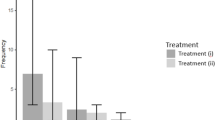Abstract
Coloration of phyllopods varies from place to place and from one life stage to another. It ranges from translucent or whitish through gray, blue, green, orange, and reddish. Here, we present experimental evidence for a food- dependent color pattern inThamnocephalus platyurus Packard. The presence or absence of the synthetic pigment trans — β — carotene in a baker's yeast diet was the controlling factor. All the 24 old larvae used in the experiment were whitish in color. From day 6 until the end the experiment (day 11), 100% of the shrimps under a diet with synthetic trans — β — carotene (treatment 1) exhibited a characteristic color pattern which consisted of an orange color in the cercopods, and in all theracopods; the rest of the body exhibited no particular color. In comparison, 100% of the shrimps under a diet without synthetic trans — β — carotene (treatment 2) were whitish throughout the body. In females from treatment 1, the ovaries and oocytes were green-bluish, while in females from treatment 2 the ovaries and oocytes were whitish. No significant differences in survival and growth were found, except that at day 9, there was a significant difference in growth, the females with the synthetic trans — β — carotene group growing faster.
Similar content being viewed by others
References
Bond, R. M., 1933. Observations onArtemia franciscana Kellog, especially on the relation of environment to morphology. Int. Revue Hydrobiol. 28: 117–125.
Bunker, H. J., 1963. Microbial food. In C. Rainbow & A. H. Rose (eds), Biochemistry of industrial micro-organisms. Academic Press, London: 34–67.
Cheesman, D. F., W. L. Lee & P. F. Zalgasky, 1967. Carotenoproteins in invertebrates. Biol. Rev. 42: 132–160.
Czeczuga, B., 1973. Carotenoids giving a specific colour to the body ofBranchinecta paludosa (O. F. Muller) (Branchiopoda) from the Dwoisty Staw Gasienicowy Lake. Lake. Bull. Acad. Polon. Sci. ser. biol. 21: 365–368.
Davis, B. H., 1976. Carotenoids. In T. W. Goodwing (ed.), Chemistry and Biochemistry of plant pigments. 2nd edn., Vol. 2: 38–365.
Dexter, R. W., 1943. A second survey of the anostracan phyllopods in northeastern Ohio. Am. Midl. Nat. 30: 336–340.
Dexter, R. W., 1946. Further studies on the life history and distribution ofEubranchipus vernalis (Verrill). Ohio J. Sci. 46: 31–44.
Dexter, R. W., 1959. Anostraca. In W. T. Edmondson (ed.), Fresh Water Biology. Wiley, New York: 559–571.
Dexter, R. W. & M. S. Ferguson, 1943. Life history and distributional studies onEubranchipus serratus Forbes (1876). Am. Midl. Nat. 29: 210–222.
Gilchrist, B. M., 1954. Haemoglobin inArtemia. Proc. r. Soc. B, 143: 136–146.
Gilchrist, B. M., 1968. Distribution and relative abundance of carotenoid pigments in Anostraca. Comp. Biochem. Physiol. 24: 123–147.
Gilchrist, B. M. & J. Green, 1960. The pigments ofArtemia. Proc. r. Soc. B. 152: 118–136.
Gilchrist, B. M. & J. Green, 1962. Bile pigment inChirocephalus diaphanus Prévost (Crustacea: Anostraca). Comp. Biochem. Physiol. 7: 117–125.
Gilchrist, B. M. & P. F Zagalsky, 1983. Isolation of a blue canthaxanthin-protein from connective tissue storage cells inBranchinecta packardi Pearse (Crustacea: Anostraca) and its possible role in vitellogenesis. Comp. Biochem. Physiol. 76B: 885–893.
Goodwing, T. W., 1960. Biochemistry of pigments. In T. H. Waterman (ed.), The Physiology of Crustacea, Vol. 1. Metabolism and growth. Academic Press, London. 101–140.
Goodwing, T. W., 1980. The Biochemistry of the carotenoids. Vol. 1. Plants. 2nd edn,, Chapman & Hall, London, 18 + 377 pp.
Goodwing, T. W., 1984. The Biochemistry of the carotenoids. Vol. 2. Animals. 3nd Ed., Chapman & Hall, London, 15 + 224 pp.
Hairston, N. G., 1980. The vertical distribution of diaptomid copepods in relation to body pigmentation. In W. C. Kerfoot (ed.), Evolution and Ecology of zooplankton communities. The University Press of New England, Darthmouth College: 98–110.
Hata, M. & M. Hata, 1969. Carotenoid metabolism inArtemia salina L. Comp. Biochem. Physiol. 29: 985–994.
Herring, P. J., 1968a. The carotenoid pigmnets ofDaphnia magna Straus-I. The pigments of the animals fedChlorella pyrenoidosa and pure carotenoids. Comp. Biochem. Physiol. 24: 187–203.
Herring, P. J., 1968b. The carotenoid pigments ofDaphia magna Strauss-II. Aspects of pigmentary metabolism. Comp. Biochem. Physiol. 24: 205–221.
Hsu, W. J. & C. O. Chichester, 1970. The metabolism of β-carotene and other carotenoids in the brine shrimp,Artemia salina L. (Crusracea: Branchiopoda). Comp. Biochem. Physiol. 32: 69–79.
Maeda-Martínez, A. M., H. Obregón-Barboza & H. J. Dumont, 1995. Laboratory culture of fairy shrimps using baker's yeast as basic food in a flow-through system. Hydrobiologia 298 (Dev. Hydrobiol. 103): 141–157.
Nelis, H. J. C. F., P. Lavens, L. Moens, P. Sorgeloos, J. A. Jonckheere, G. Criel & A. P. De Leenheer, 1984.cis- Canthaxanthins, unusual carotenoids in the eggs and the reproductive system of female brine shrimpArtemia. J. Biol. Chem. 259: 6063–6066.
Packard, A. S., 1883. A monograph of the phyllopod Crustacea of North america with remarks on Order Phyllocarida. 12th Ann. Rept. U. S. Geol. Geogr. Surv. Terr. Part I: 295-592.
Partali, V., Y. Olsen, P. Foos & S. Liaaen-Jensen, 1985. Carotenoids in food chain studies—I. ZooplanktonDaphnia Magna response to a unialgalScenedesmus acutus carotenoid diet, to spinach, and to yeast diets supplemented with individual carotenoids. Comp. Biochem. Physiol. 82B: 767–772.
Pennak, R. W., 1989. Fresh-water invertebrates of the United States 3rd Ed., Wiley, New York, 16+628 pp.
Wilkinson, L., 1990. SYSTAT: The system for statistics. SYSTAT, Inc., Evanston, IL.
Author information
Authors and Affiliations
Rights and permissions
About this article
Cite this article
Maeda-Martinez, A.M., Obregón, H. & Dumont, H.J. Food dependent color patterns inThamnocephalus platyurus Packard (Branchiopoda: Anostraca); a laboratory study. Hydrobiologia 298, 133–139 (1995). https://doi.org/10.1007/BF00033808
Issue Date:
DOI: https://doi.org/10.1007/BF00033808




